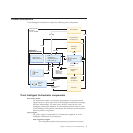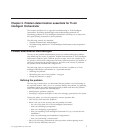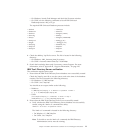v What was the first symptom of the problem? Have you noticed other symptoms
occurring simultaneously?
v Does the problem affect only one system or multiple systems?
v Did you receive an error message indicating what the problem is?
v If the problem can be reproduced, what are the steps that you need to perform
to recreate it?
Identifying the cause of the problem
The information you gathered during the previous phase helped you to correctly
identify the problem and describe the context that triggered it. To be able to
identify and locate the cause of the problem, it is very important that you
understand the Tivoli Intelligent Orchestrator architecture and the interaction
between its components. This will help you to determine the specific component
that is involved with the problem:
v Data center model
v Policy engine
v Deployment engine
v Automation packages
v Discovery technologies
v Management interface
Problems
limited to a single product component have causes that are easier to
identify. Other problems might affect various components and their causes might
be subtle and more difficult to identify. Furthermore, different problems may have
the same symptoms, but different causes. Ideally, you should be able to approach
the problem in such a way so that you can isolate it to a single component.
If you cannot identify the cause of a problem, you might want to seek the
assistance of the Tivoli Support team, who will be able to pinpoint the cause of the
problem and recommend ways to recover from specific situations. For more
information on how to contact the IBM Tivoli Software Support, refer to Chapter 9,
“Contacting IBM Tivoli Software Support,” on page 91.
As Tivoli Intelligent Orchestrator integrates many different products, some of the
problem determination issues that might be considered difficult at times are:
Determining where the problem lies and what it is
The first challenge would be to determine if the problem is a customer
error, triggered by an incorrect use of the product, or an error of the
product itself, that is, a defective piece of software or hardware. Errors
encountered at startup are often missed, resulting in symptoms that are
encountered down the road. It is always worthwhile verifying whether
problems or exceptions are encountered at startup, before debugging a
symptom found down the road. Any problem found in a startup trace
should be addressed first.
Verifying whether the problem can be replicated
You need a non-production environment on which to replicate the problem
and do all tracing and analysis. Having a non-production environment
available would also allow you to test the problem on different platforms.
Checking
whether the problem has occurred before
If the same problem or a similar problem have been dealt with before, it is
very likely that extensive support documentation is provided. Begin by
8 Tivoli Intelligent Orchestrator Problem Determination and Troubleshooting Guide


















